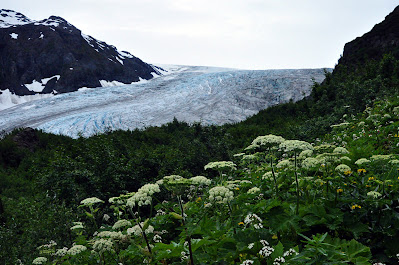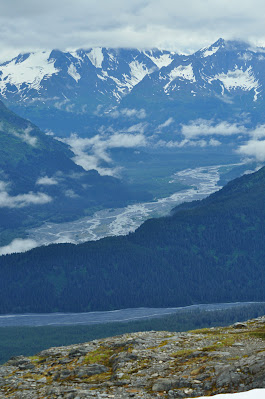Having nearly a full day in Seward before we had to be on our cruise ship meant there was plenty of time to have some fun. Danelle found some info on the Harding Icefield Trail, which seemed intriguing. When National Geographic named it one of the 20 best hikes in our national parks, I was sold.
I figured it would take between six to eight hours to cover the 8.4 miles and 3,000 feet of elevation gain, so I had to get an early start. Up at 5 a.m., at the trailhead by 6. It wasn't too long ago that I wouldn't dream of getting up that early on a vacation.
The trail rose quickly to provide nice views of the misty glacial valley. But between the overcast conditions and early hour there wasn't much light for pictures.
Just over an hour in I got my first good look at Exit Glacier.
Multiple hikers reported seeing a small black bear by this waterfall on my way back down. But thanks to my bear bells I never saw him. As much as I wanted to see bears on our trip, alone on a hiking trail wasn't my first choice.
There was a lot of blue-pod lupine along the trail, mostly encased in a thin layer of ice.
As the light grew stronger, the blue coloration in the glacial ice became more obvious.
The orange flags along the highest section of the trail did prove to be quite a help. There were several spots where it wasn't otherwise obvious where exactly to walk.
Several small waterfalls ran down the rocky slopes, and made the only sounds in the otherwise still environment.
When I first noticed red blotches in the snow I thought they might be blood from some predator's meal. Then I saw more red than a blue whale could have provided, so I guess it's actually from some sort of mineral in the rocks.
The emergency shelter provided a welcome sight, since it indicated the end of the trail was only another third of a mile away.
In the desolate landscape the grim little shack was actually a bit creepy. I knocked on the door before opening it, half expecting some crazed hermit to be in residence. There wasn't one.
The end of the trail wasn't marked by any sign. The orange flags just suddenly stopped, and you were left looking out over ice and snow as far as the eye could see. It took my breath away.
Even in extreme conditions like these, life finds a way to eke out an existence.
Switching to monochrome really emphasized some of the interesting textures in the ice.
The silt-covered riverbeds made it easy to trace the paths of other nearby glaciers that were also receding back into the icefield.
Click here for Part II.















No comments:
Post a Comment